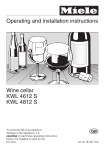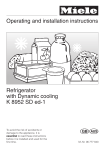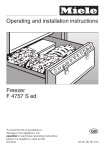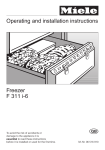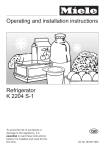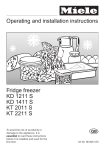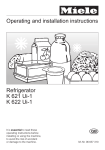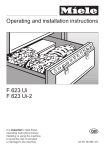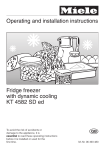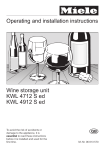Download Miele KWL 4812 S Operating instructions
Transcript
Operating and installation instructions Wine cellar KWL 4612 S KWL 4812 S To avoid the risk of accidents or damage to the appliance, it is essential to read these operating instructions before it is installed or used for the first time. G M.-Nr. 06 Contents Description of the appliance . . . . . . . . . . . . . . . . . . . . . . . . . . . . . . . . . . . . . . . . . 4 Caring for the environment . . . . . . . . . . . . . . . . . . . . . . . . . . . . . . . . . . . . . . . . . . 6 Warning and Safety instructions . . . . . . . . . . . . . . . . . . . . . . . . . . . . . . . . . . . . . 7 How to save energy . . . . . . . . . . . . . . . . . . . . . . . . . . . . . . . . . . . . . . . . . . . . . . . 10 Operation . . . . . . . . . . . . . . . . . . . . . . . . . . . . . . . . . . . . . . . . . . . . . . . . . . . . . . . 11 Safety lock . . . . . . . . . . . . . . . . . . . . . . . . . . . . . . . . . . . . . . . . . . . . . . . . . . . . . . . 11 The correct temperature and humidity . . . . . . . . . . . . . . . . . . . . . . . . . . . . . . . 12 Temperature . . . . . . . . . . . . . . . . . . . . . . . . . . . . . . . . . . . . . . . . . . . . . . . . . . . . . . 12 Safety features . . . . . . . . . . . . . . . . . . . . . . . . . . . . . . . . . . . . . . . . . . . . . . . . . 12 Setting the temperature . . . . . . . . . . . . . . . . . . . . . . . . . . . . . . . . . . . . . . . . . . 12 Temperature range . . . . . . . . . . . . . . . . . . . . . . . . . . . . . . . . . . . . . . . . . . . . . . 13 Temperature display . . . . . . . . . . . . . . . . . . . . . . . . . . . . . . . . . . . . . . . . . . . . . . . 13 Temperature display brightness . . . . . . . . . . . . . . . . . . . . . . . . . . . . . . . . . . . . 13 Humidity level . . . . . . . . . . . . . . . . . . . . . . . . . . . . . . . . . . . . . . . . . . . . . . . . . . . . 13 Air filtering with the active charcoal filter and dynamic cooling . . . . . . . . . . . . 14 Storing wine bottles. . . . . . . . . . . . . . . . . . . . . . . . . . . . . . . . . . . . . . . . . . . . . . . 15 Wooden shelves. . . . . . . . . . . . . . . . . . . . . . . . . . . . . . . . . . . . . . . . . . . . . . . . . . . 15 Descriptive labels . . . . . . . . . . . . . . . . . . . . . . . . . . . . . . . . . . . . . . . . . . . . . . . . . 15 Maximum capacity. . . . . . . . . . . . . . . . . . . . . . . . . . . . . . . . . . . . . . . . . . . . . . . . . 15 Alarm . . . . . . . . . . . . . . . . . . . . . . . . . . . . . . . . . . . . . . . . . . . . . . . . . . . . . . . . . . . 16 Temperature alarm . . . . . . . . . . . . . . . . . . . . . . . . . . . . . . . . . . . . . . . . . . . . . . . . . 16 Door alarm . . . . . . . . . . . . . . . . . . . . . . . . . . . . . . . . . . . . . . . . . . . . . . . . . . . . . . . 16 Switching on the alarm system . . . . . . . . . . . . . . . . . . . . . . . . . . . . . . . . . . . . . . . 16 Switching the alarm off early . . . . . . . . . . . . . . . . . . . . . . . . . . . . . . . . . . . . . . . . . 16 Defrosting . . . . . . . . . . . . . . . . . . . . . . . . . . . . . . . . . . . . . . . . . . . . . . . . . . . . . . . 17 Cleaning and care . . . . . . . . . . . . . . . . . . . . . . . . . . . . . . . . . . . . . . . . . . . . . . . . 18 Cleaning the outer casing, the interior and accessories . . . . . . . . . . . . . . . . . . . . 18 Ventilation gaps . . . . . . . . . . . . . . . . . . . . . . . . . . . . . . . . . . . . . . . . . . . . . . . . . . . 18 Door seal . . . . . . . . . . . . . . . . . . . . . . . . . . . . . . . . . . . . . . . . . . . . . . . . . . . . . . . . 19 Metal grille at the back of the appliance . . . . . . . . . . . . . . . . . . . . . . . . . . . . . . . . 19 Active charcoal filter . . . . . . . . . . . . . . . . . . . . . . . . . . . . . . . . . . . . . . . . . . . . . . . 19 Problem solving guide. . . . . . . . . . . . . . . . . . . . . . . . . . . . . . . . . . . . . . . . . . . . . 20 Noises . . . . . . . . . . . . . . . . . . . . . . . . . . . . . . . . . . . . . . . . . . . . . . . . . . . . . . . . . 22 Service Department . . . . . . . . . . . . . . . . . . . . . . . . . . . . . . . . . . . . . . . . . . . . . . . 23 Electrical connection . . . . . . . . . . . . . . . . . . . . . . . . . . . . . . . . . . . . . . . . . . . . . . 24 Electrical connection U.K. . . . . . . . . . . . . . . . . . . . . . . . . . . . . . . . . . . . . . . . . . . . 24 Contents Installation . . . . . . . . . . . . . . . . . . . . . . . . . . . . . . . . . . . . . . . . . . . . . . . . . . . . . . 25 Location . . . . . . . . . . . . . . . . . . . . . . . . . . . . . . . . . . . . . . . . . . . . . . . . . . . . . . . . . 25 Climate range . . . . . . . . . . . . . . . . . . . . . . . . . . . . . . . . . . . . . . . . . . . . . . . . . . 25 Ventilation. . . . . . . . . . . . . . . . . . . . . . . . . . . . . . . . . . . . . . . . . . . . . . . . . . . . . . . . 25 Installation . . . . . . . . . . . . . . . . . . . . . . . . . . . . . . . . . . . . . . . . . . . . . . . . . . . . . . . 25 Aligning the appliance . . . . . . . . . . . . . . . . . . . . . . . . . . . . . . . . . . . . . . . . . . . . . . 25 Changing the door hinging . . . . . . . . . . . . . . . . . . . . . . . . . . . . . . . . . . . . . . . . . 26 Description of the appliance a Safety lock indicator light d On/Off button b Temperature display e Locking button c Controls for setting the temperature upper button: warmer lower button: colder f Alarm off button 4 Description of the appliance a Interior lighting b Wooden shelf with décor strip for descriptive labels c Lock d Condensate channel and drain hole e Active charcoal filter f Grille 5 Caring for the environment Disposal of the packing material The transport and protective packing has been selected from materials which are environmentally friendly for disposal, and can normally be recycled. Ensure that any plastic wrappings, bags etc. are disposed of safely and kept out of the reach of babies and young children. Danger of suffocation! Rather than just throwing these materials away, please ensure that they are recycled. Disposal of your old appliance Please ensure that the appliance presents no danger to children while being stored for disposal. It should be unplugged or disconnected from the mains electricity supply by a competent person. The plug must be rendered useless and the cable cut off directly behind the appliance to prevent misuse. See the "Warning and Safety" section of this booklet for further details. Electrical and electronic appliances often contain materials which, if handled or disposed of incorrectly, could be potentially hazardous to human health and to the environment. They are, however, essential for the correct functioning of your appliance. Please dispose of your old appliance at your local community waste collection / recycling centre and not with your household waste. Take care not to damage the pipework at the back of it before or during transportation to an authorised collection depot. In this way, refrigerant in the pipework and oil in the compressor will be contained, and will not leak out into the environment. 6 Warning and Safety instructions Technical safety This appliance complies with all relevant legal safety requirements. Improper use of the appliance can, however, present a risk of both personal injury and material damage. To avoid the risk of accidents and damage to the appliance, read the operating instructions carefully before installation and before using for the first time. They contain important notes on the installation, safety, operation and care of the appliance. Keep these instructions in a safe place and pass them on to any future user. Correct usage This appliance is intended for domestic use only for storing wine. Any other usage is not supported by the manufacturer and could be dangerous. The manufacturer cannot be held liable for damage caused by incorrect or improper use of the appliance. This appliance contains the coolant Isobutane (R600a), a natural gas which breaks down naturally. It is however flammable. Care must be taken during transportation and setting up of the appliance that no parts of the cooling system are damaged. Leaking coolant can damage the eyes. In the event of any damage: - avoid open fires and anything which creates a spark, - disconnect from the mains, - air the room in which the appliance is located for several minutes and - contact the Service Department for advice. The more coolant there is in an appliance, the larger the room it should be installed in. In the event of a leakage, if the appliance is in a small room, there is the danger of combustible gases building up. For every 8 g of coolant at least 1 m3 of room space is required. The amount of coolant in the appliance is stated on the data plate inside the appliance. Before connecting the appliance to the mains supply, make sure that the rating on the data plate corresponds to the voltage and frequency of the household supply. This data must correspond in order to avoid the risk of damage to the appliance. If in any doubt, consult a qualified electrician. 7 Warning and Safety instructions The electrical safety of this appliance can only be guaranteed when continuity is complete between the appliance and an effective earthing system which complies with local and national safety regulations. It is most important that this basic safety requirement is present and tested regularly and where there is any doubt, the household wiring system should be inspected by a qualified electrician. The manufacturer cannot be held liable for the consequences of an inadequate earthing system (e.g. electric shock). Safe operation of the appliance is only assured if it has been installed and connected in accordance with these operating and installation instructions. This equipment may only be used in mobile installations such as ships, caravans, aircraft etc. if a risk assessment of the installation has been carried out by a suitably qualified engineer. Installation work, maintenance and repairs may only be carried out by suitably qualified and competent persons in accordance with national and local safety regulations. Repairs and other work by unqualified persons could be dangerous and the manufacturer will not be held liable. Ensure current is not supplied to the appliance until after maintenance or repair work has been carried out. 8 The appliance is only completely isolated from the electricity supply when: – it has been switched off at the wall socket and the plug has been withdrawn. – the mains fuse is withdrawn, or – the screw-out fuse is removed (in countries where this is applicable). Do not connect the appliance to the mains electricity supply by an extension lead. Extension leads do not guarantee the required safety of the appliance (e.g. danger of overheating). Use Never store explosive materials in the appliance. Thermostats switching on may produce sparks which could present a fire hazard. Flammable compounds could explode. Do not use any oils or grease on the door seals, as these will cause the seals to deteriorate and become porous with time. Do not block the ventilation gaps in the appliance as this would impair the efficiency of the appliance, increase the electricity consumption and could cause damage to the appliance. Warning and Safety instructions The appliance is designed for use within certain climate ranges (ambient temperatures), and should not be used outside this range. The climate range for your appliance is stated on the data plate inside the appliance. Installing it in a room with too low an ambient temperature, e.g. a garage, can lead to the appliance switching off for longer periods so that it cannot maintain the required temperature. Do not use a steam-cleaning appliance to clean this appliance. Pressurised steam could reach the electrical components and cause a short circuit. In countries where there are areas which may be subject to infestation by cockroaches or other vermin, pay particular attention to keeping the appliance and its surroundings in a clean condition at all times. Any damage which may be caused by cockroaches or other vermin will not be covered by the guarantee. Disposal of your old appliance Before disposing of an old appliance, first make the door latch or lock unusable. This way you will prevent children from accidentally locking themselves in and endangering their lives. Before disposing of an old appliance, unplug it and render the plug useless. Cut off the cable directly behind the appliance and at the plug to prevent misuse. Be careful not to damage any part of the pipework whilst awaiting disposal, e.g. by – puncturing the refrigerant channels in the evaporator. – bending any pipework. – scratching the surface coating. Splashes of refrigerant can damage the eyes. The manufacturer cannot be held liable for damage caused by non-compliance with these Warning and Safety instructions. 9 How to save energy Installation normal energy consumption increased energy consumption In a ventilated room. In an enclosed, unventilated room. Protected from direct sunlight. In direct sunlight. Not situated near to a heat source (radiator, oven). Situated near to a heat source (radiator, oven). Where the ambient room temperature is ideal at approx. 20°C. Where there is a high ambient room temperature. Temperature setting with With a medium setting of 2 to 3. a thermostat which is approximate (set in stages). With a high setting: The lower the compartment temperature, the higher the energy consumption. Temperature setting with Cellar section 8 to 12°C a thermostat which is Refrigerator section 4 to 5 °C exact to the degree (digital display). StayFresh zone approx. 0°C Freezer section -18°C On appliances with winter setting, please make sure that the winter setting is switched off when the ambient temperature is warmer than 16 °C. Only open the door when necessary and for as short a time as possible. Frequent opening of the door for long periods will cause a loss of coldness. Store food in an organised way. If food is not stored in an organised way, searching for an item will mean the door is open for longer. Allow hot food and drinks to cool down before placing them in the appliance. Placing hot food in the appliance will cause the compressor to run for a long time, as the appliance will have to work harder to lower the temperature. Store food covered or packaged. The evaporation or condensation of liquids will cause a loss of coldness in the refrigerator. Use Place frozen food in the refrigerator to defrost. Do not over-fill the sections to allow air to circulate. Defrosting 10 Defrost the freezer section when a layer of ice one centimetre thick has built up. A layer of ice hinders the cold from reaching the frozen food, and causes an increase in energy consumption. Operation Before using for the first time Switching off ^ Clean the inside of the appliance and the accessories with warm water and a little washing up liquid and then dry with a soft cloth. ^ Press the On-Off button. Important: To ensure correct functioning of the appliance, let it stand for between ½ and 1 hour after transporting it to its final location before connecting it to the mains. The temperature display goes out and the cooling process is switched off. (If this does not happen, the safety lock is still engaged). Safety lock The safety lock can be engaged to prevent the temperature being changed or the appliance being switched off unintentionally. Switching on To activate the safety lock ^ Press the On-Off button. The temperature display will start flashing and the alarm will sound. The appliance starts cooling. The interior light will come on when the door is opened. Switching off the alarm ^ Press and hold the locking button, until a beep is heard and the safety lock indicator light d in the temperature display lights up. The appliance can now not be switched off and the temperature can not be adjusted until the lock has been de-activated. De-activating the safety lock ^ Press the alarm button. The alarm stops. The temperature display will continue to flash until the temperature range set has been reached. ^ Press and hold the locking button, until the locking indicator light in the temperature display goes out. The appliance can now be switched off at any time and the temperature adjusted. 11 The correct temperature and humidity Wine keeps on maturing depending on the surrounding conditions. The length of time for which wine can be kept in good condition will depend on the temperature as well as on the air humidity. Temperature Wine can be stored at a temperature between 5°C and 18°C. The optimum temperature is around 10-12°C. Most white wines can be consumed at this temperature. It is best to take red wine out of the wine cellar about two hours before drinking. Open the wine to allow it to breathe and to develop its aroma. After two hours red wine will be at the correct temperature for drinking. If wine is stored at a temperature above 22°C it will mature too quickly. Wine should not be stored below 5°C for a long period of time as it will not mature fully at this low temperature. Fluctuations in temperature put wine under stress and interrupt the maturing process. It is therefore very important to maintain a constant temperature. An ambient room temperature of 8-43°C will ensure that a constant temperature is maintained in the appliance. (This is a wider temperature range than the climate range quoted on the data plate). Safety features A thermostat prevents the temperature in the wine cellar falling below 2°C. If the external temperature should drop below this level, a heater element in the appliance switches on automatically to keep the temperature inside as constant as possible. Setting the temperature The temperature is set using the two buttons next to the temperature display. Press the upper button: to increase the temperature (it gets warmer) lower button: to reduce the temperature (it gets colder) The temperature being set will flash in the display. When pressing the buttons, the following information shows in the display: – When first pressed, the last temperature selected flashes. – Each subsequent press of the button adjusts the temperature shown in 1 °C steps. – Keeping the button pressed in adjusts the temperature continually. Approx. 5 seconds after letting go of the button, the current temperature inside the appliance is automatically shown. 12 The correct temperature and humidity Temperature range The temperature can be adjusted from 5°C to 22°C. Temperature display During normal operation, the temperature display on the control panel shows the temperature inside the appliance. If the temperature in the appliance is not within the range that the appliance is able to display (i.e. 2-30°C), only bars will light up in the temperature display. Depending on the ambient temperature and the setting, it can take the appliance up to 8 hours to reach the temperature required and for this temperature to then be shown as a constant temperature in the display. The temperature display will flash, if – a different temperature is being set, – the temperature in the wine cellar is too high or too low. Temperature display brightness The appliance is supplied with the brightness of the temperature display set as low as possible. However, if the door is opened, a setting changed or if the alarm is sounding, the temperature display will appear much brighter for approx. 1 minute. pressing the upper button next to the temperature display. – Dimmer: by pressing the alarm off button, and whilst holding it in, pressing the lower button next to the temperature display. Humidity level It is very important to store wine in an atmosphere with a high humidity level (60-70 %) so that the corks remain moist on the outside. A refrigerator with its low humidity level is therefore not the best place to store wine. Low humidity causes corks to dry out from the outside, and so they do not seal the bottles as tightly. Wine should be stored lying down to keep the corks moist from the inside too! Air entering the bottle will inevitably spoil the wine. Ideal humidity levels can be maintained inside the appliance as long as the ambient room temperature is between 15°C and 35°C. Useful tip: Before serving, stand the wine upright for at least two hours, or the entire day if possible, to allow any sediment to settle at the bottom of the bottle. The level of brightness can be adjusted to be: – Brighter: by pressing the alarm off button and, whilst holding it in, 13 The correct temperature and humidity Air filtering with the active charcoal filter and dynamic cooling The active charcoal filter and the dynamic cooling system work together to ensure a good air flow is maintained throughout the cabinet and thus achieve optimum air quality. The dynamic cooling system draws fresh air with a humidity level of 60-70% from outside the appliance, in through the active charcoal filter and distributes it evenly around the interior. Filtering the incoming air through the active charcoal filter ensures that all the air entering the appliance is fresh and free from dust. Because the temperature is constant and evenly distributed throughout the unit you have the reassurance that all your wines are being kept in the same condition. Replace the active charcoal filter with a new one once a year (see "Cleaning and care"). These are available from your dealer. 14 Storing wine bottles Wooden shelves Descriptive labels Any vibration or movement of the bottle can affect the wine by interrupting the natural respiration process and so impair the taste. Use the labels supplied to identify your wine quickly and easily. Insert the labels into the wooden shelf fronts from above. As far as possible, store bottles of the same type of wine beside each other on the same shelf. Removing a bottle of one type will then leave the other types undisturbed and will avoid the need to move different bottles around. Additional labels can be purchased from your dealer or from the Miele Spare Parts Department. You can adjust the height of the wooden shelves to suit your individual requirements. Maximum capacity The following data was obtained using standard Bordeaux wine bottles (0.75 l) and the number of shelves supplied with the appliance. – KWL 4612 S: up to 169 bottles – KWL 4812 S: up to 196 bottles 15 Alarm Your appliance is fitted with a warning system which ensures that the temperature cannot rise or fall unnoticed and impair the wine. Temperature alarm The alarm will sound if the temperature in the appliance rises approx. 4°C above or falls approx. 4°C below the set temperature. The temperature display will flash at the same time. The alarm will sound and the temperature display will flash: Switching on the alarm system The alarm system is always active. It does not have to be switched on manually. Switching the alarm off early Once the set temperature has been reached in the appliance, the alarm stops and the temperature display lights up constantly. However, if the noise disturbs you, you can switch the alarm off before this if you wish. – when you switch the appliance on for the first time. – when you switch the appliance on if the temperature in the appliance is very different from the temperature set. – when there has been a lengthy interruption to the power supply. Door alarm The alarm will sound if the door is left open for more than approx. 3 minutes. 16 ^ Press the alarm off button. The alarm will stop. The temperature display will continue to flash until the set temperature has been reached or the door has been shut again. The display then lights up constantly, and the alarm system is now fully active once more. Defrosting Condensate and frost can build up on the back wall of the appliance whilst it is in use. These are automatically removed and defrosted by the appliance. The condensate is drained away via a channel and drain hole into an evaporation system at the back of the appliance. Ensure that the condensate channel and drain hole are never blocked so that condensate can flow away without hindrance. 17 Cleaning and care Never use cleaning agents containing abrasive substances such as sand, soda, acids or chemical solvents. "Non-abrasive" cleaning agents are also unsuitable as they can cause matt areas to appear. Make sure that water cannot get into the electronic unit or into the lighting. Do not let water get into the drainage channel and drain hole when cleaning. Do not use steam cleaning apparatus to clean the appliance. Steam could reach the electrical components and cause a short circuit. The data plate located inside the appliance must not be removed. It contains information which is required in the event of a Service call. Before cleaning ^ Switch the appliance off at the wall socket and remove the plug. ^ Take out any removable parts, e.g. shelves, for cleaning. 18 Cleaning the outer casing, the interior and accessories Use warm water with a little washing up liquid. Accessories and shelves should all be hand-washed only. ^ Clean the condensate channel and drain hole frequently, so that condensate can drain away unhindered. Use a straw or similar to clear the drain if necessary. ^ After cleaning, wipe the outer casing, the interior and accessories with a damp cloth and dry with a soft cloth. Leave the door open to air the appliance for a short while. E-Cloth ^ A microfibre "E-Cloth" is available from the Miele UK Spare Parts Department which is suitable for cleaning surfaces such as stainless steel, glass, plastic and chrome without the use of chemicals. Ventilation gaps ^ The ventilation gaps should be cleaned regularly with a brush or vacuum cleaner. A build-up of dust will increase the energy consumption of the appliance. Cleaning and care Door seal Do not use any oils or grease on the door seal as these will cause the seal to deteriorate and become porous over time. Active charcoal filter Replace the active charcoal filter with a new one once a year. Active charcoal filters are available from your dealer or the Miele Spare Parts Dept. The door seal should be cleaned regularly with clean water and then wiped dry with a soft cloth. Metal grille at the back of the appliance The metal grille at the back of the appliance (heat exchanger) should be dusted at least once a year. A build-up of dust will increase the energy consumption of the appliance. When cleaning the grille, make sure that the pipework and other components do not get broken or damaged in any way. ^ Turn the filter 90° clockwise or anti-clockwise. ^ Remove the filter. ^ Insert a new filter with the handle in the vertical position. ^ Turn the filter 90° clockwise or anti-clockwise until it clicks into position. After cleaning ^ Replace all shelves in the appliance. ^ Insert the plug in the socket and switch the appliance back on. 19 Problem solving guide Repairs to electrical appliances should only be carried out by a suitably qualified and competent person in accordance with local and national safety regulations. Repairs and other work by unqualified persons could be dangerous. The manufacturer cannot be held liable for unauthorised work. Ensure current is not supplied to the appliance until after maintenance or repair work has been carried out. Some minor problems can be corrected without contacting the Miele Service Department. ^ Check whether the appliance door is being opened frequently. ^ Check that the door has been closed properly. . . . the alarm sounds and the temperature display flashes. ^ Has the appliance been switched on for the first time? If not, then the temperature inside the appliance is higher or lower than the temperature that has been set. This could be due to: ^ the appliance door being opened too often. What to do if . . . ^ a blocked ventilation gap. . . . the appliance does not get cool. ^ a lengthy interruption to the power supply. ^ Check whether the appliance has been switched on. The temperature display must be lit up. Once the problem has been resolved the temperature display will light up constantly and the alarm will stop. ^ Check that the plug is correctly inserted in the socket and switched on. . . . a bar is lit up or flashing in the temperature display. ^ Check that the fuse is not defective and that the mains fuse has not blown. If it has, contact the Miele Service Department. Only temperatures within the range the appliance can display will be shown. If the temperature is not within this range, a bar will be displayed instead. . . . the appliance is switching in too frequently and for too long. ^ Check whether the ventilation gaps have been covered over or become too dusty. ^ Check whether the metal grille (heat exchanger) at the back of the appliance has become too dusty. 20 . . . "F1" or "FU" appears in the temperature display. There is a fault. Call the Service Department. . . . you cannot switch the appliance off. The safety lock has been activated. Problem solving guide . . . the interior light is not working. ^ Was the door left open for too long? The light switches itself off automatically after approx. 15 minutes. If you still cannot remedy the fault having followed these suggestions, please contact the Miele Service Department. If this is not the case, then the lamp is defective. To prevent unnecessary loss of temperature it is advisable not to open the door while waiting for the appliance to be serviced. ^ Disconnect the appliance from the mains. Switch off at the wall and withdraw the plug from the socket, or disconnect the mains fuse or remove the screw-out fuse in countries where this is applicable. ^ Unscrew the lamp and replace it with a new one. Lamp specification: 220 - 240 V, max. 15 W, E 14 fitting. ^ Screw the new lamp into the connection. 21 Noises Normal noises What causes them Brrrrr... Humming noise made by the motor (compressor). This noise can get louder for brief periods when the motor is switching on. Blubb, blubb.... A gurgling noise can be heard when coolant is circulating through the pipes. Click.... Clicking sounds are made when the thermostat switches the motor on and off. Sssrrrrr.... On multi-zone and frost free appliances you can sometimes just hear the movement of air circulating inside the appliance. Remember that the noise of the compressor and the coolant circulating in the system is unavoidable. Noises that you can easily rectify What causes them, and what can you do about them? Rattling, vibrating The appliance is uneven: Realign the appliance using a spirit level, by raising or lowering the screw feet underneath the appliance. The appliance is touching another appliance or piece of furniture: Move it away. Drawers, baskets or shelves are unstable or sticking: Check all removable items and refit them correctly. Are any bottles or containers unstable or knocking against each other? Separate them. The transport cable clips are hanging loose at the back of the appliance: Remove the clips. 22 Service Department In the event of a fault which you cannot correct yourself, or if the appliance is under guarantee, please contact: – Your Miele Dealer or – The Miele Service Department (see back cover for address). When contacting your Dealer or the Service Department, please quote the model and serial number of your appliance. This information is given on the data plate. Please note that telephone calls may be monitored and recorded to improve our service. 23 Electrical connection Electrical connection U.K. Non-rewireable plugs (BS 1363) All electrical work should be carried out by a suitably qualified and competent person in accordance with local and national safety regulations. The fuse cover must be re-fitted when changing the fuse, and if the fuse cover is lost, the plug must not be used until a suitable replacement is obtained. The colour of the correct replacement cover is that of the coloured insert in the base of the plug, or the colour that is embossed in words in the base of the plug (as applicable to the design of the plug fitted). The appliance is supplied with a mains cable and moulded plug ready for connection to an a.c. single phase 220-240 V 50 Hz supply. The voltage and connected load are given on the data plate. Please ensure that these match the household mains supply. The fuse rating is quoted on the plug. Connection should be made via a suitable switched socket which is easily accessible. For extra safety it is advisable to install a residual current device (RCD) with a trip current of 30 mA (in accordance with DIN VDE 0664, VDE 0100, Section 739). Do not connect the appliance to the mains electricity supply by an extension lead. Extension leads do not guarantee the required safety of the appliance (e.g. danger of overheating). The appliance must not be connected to an inverter and must not be used with a plug adapter as these can cause damage to the appliance's electronic unit. 24 Replacement fuses should be ASTA approved to BS 1362 and have the correct rating. Replacement fuses and fuse covers may be purchased from your local electrical supplier. WARNING THIS APPLIANCE MUST BE EARTHED Installation Ventilation Do not place any appliance which gives off heat, such as a toaster or microwave oven, on top of this appliance, as this would increase the appliance's energy consumption. Location The appliance should be installed in a dry, well-ventilated room. The room temperature should not go above or below the climate range for which the appliance is designed. The higher the ambient temperature of the room, the more energy the appliance requires to operate. It should not be installed where it is exposed to direct sunlight or directly adjacent to a heat-producing appliance such as an oven or a radiator. The appliance can be placed directly against a wall. To ensure sufficient ventilation, the ventilation gaps must not be covered over. The air inlet and outlet must not be covered or blocked in any way. They should be dusted on a regular basis. Installation ^ Remove any cable clips from the back of the appliance. ^ Check that all parts at the back of the appliance are unhindered. Remove any hindrance. ^ Carefully push the appliance into position. Aligning the appliance Climate range The climate range of the appliance is stated on the data plate inside the appliance. Climate range Ambient room temperature SN N ST T +10°C to +32°C +16°C to +32°C +18°C to +38°C +18°C to +43°C ^ To align the appliance adjust the feet using the spanner supplied. This appliance can operate in a wider room temperature range than indicated by the climate range. A constant temperature will be maintained in the appliance at an ambient room temperature of 8 to 43 °C. It is important that the room temperature should be kept within this range. 25 Changing the door hinging The appliance is supplied right hand hinged. If left hand door hinging is required, follow the instructions below. ^ Remove the cover caps from the opposite side, and fit them into the empty holes. Removing the door handle: Changing over the door: First the side section of the handle must be removed: ^ Pull door handle a towards you. Side section b slides back, creating a gap d between side section b and mounting plate c. ^ Place a suitable object (e.g. a spoon handle) in gap d, and slowly lever the handle towards the door. Be careful not to let the "spoon handle" slip, causing damage to the appliance. The side section b can now be removed. ^ Pull side section b out of the guides on the mounting plate. ^ Loosen the 4 screws (Torx 15) in the mounting plate, and remove the handle. 26 ^ Close the appliance door, unscrew hinge bracket a, and take the door off. ^ Take hinge pin b out of the hinge bracket, then refit it in the second hole of the hinge bracket. (Use the spanner supplied to unscrew and refit the hinge pin). ^ Use the spanner supplied to unscrew upper hinge pin c, and refit it on the other side. ^ Remove stoppers d, and unscrew bracket e . Refit the bracket and stoppers on the other side of the door. Changing the door hinging ^ Rotate the door 180°. Refitting the handle: ^ Remove cover f and use it to cover the now empty holes on the opposite side. ^ Next, screw the handle on loosely. The mounting plate must fit snugly to the door housing. If it doesn't: ^ Hang the door on the upper hinge pin and close the door. ^ Fit the hinge bracket in the lower door bearing. Then screw it securely to the appliance plinth. Use the long slots in the hinge bracket to align the door. ^ Tighten the two screws a with the allen key provided as far as they will go. ^ Tighten screws b. Slide the side section of the handle into the guides on the mounting plate until it clicks into place. 27 Alteration rights reserved / 2604 KWL 4612 S, KWL 4812 S M.-Nr. 06 / en - GB




























